
The geometer moths are moths belonging to the family Geometridae of the insect order Lepidoptera, the moths and butterflies. Their scientific name derives from the Ancient Greek geo γῆ or γαῖα "the earth", and metron μέτρον "measure" in reference to the way their larvae, or "inchworms", appear to "measure the earth" as they move along in a looping fashion. A very large family, it has around 23,000 species of moths described, and over 1400 species from six subfamilies indigenous to North America alone. A well-known member is the peppered moth, Biston betularia, which has been subject of numerous studies in population genetics. Several other geometer moths are notorious pests.
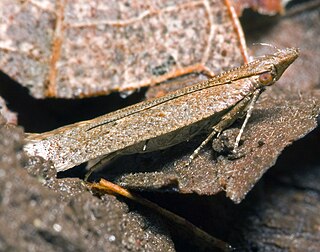
The Gelechiidae are a family of moths commonly referred to as twirler moths or gelechiid moths. They are the namesake family of the huge and little-studied superfamily Gelechioidea, and the family's taxonomy has been subject to considerable dispute. These are generally very small moths with narrow, fringed wings. The larvae of most species feed internally on various parts of their host plants, sometimes causing galls. Douglas-fir (Pseudotsuga) is a host plant common to many species of the family, particularly of the genus Chionodes, which as a result is more diverse in North America than usual for Gelechioidea.

The small fan-footed wave is a moth of the family Geometridae. The species was first described by Johann Siegfried Hufnagel in 1767.
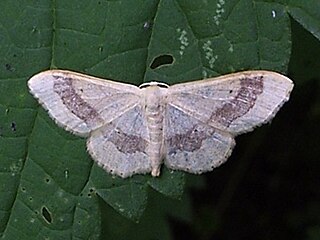
The riband wave is a moth of the family Geometridae. The species was first described by Carl Linnaeus in his 1758 10th edition of Systema Naturae.

Idaea, sometimes called Hyriogona, is a large genus of geometer moths. It was erected by Georg Friedrich Treitschke in 1825. They are found nearly worldwide, with many native to the Mediterranean, the African savannas, and the deserts of western Asia.

Idaea dimidiata, the single-dotted wave, is a moth of the family Geometridae. It is a Holarctic species.
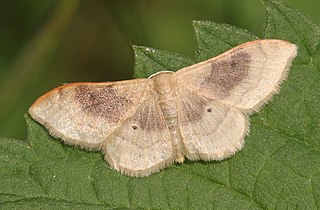
Idaea degeneraria, the Portland ribbon wave, is a moth of the family Geometridae. The species was first described by Jacob Hübner in 1799.

Idaea inversata, the purple wave, is a moth of the family Geometridae. The species was first described by Achille Guenée in 1857. It is found along the east coast of Australia.
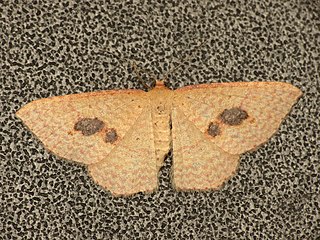
Epicyme is a monotypic moth genus in the family Geometridae described by Edward Meyrick in 1885. Its only species, Epicyme rubropunctaria, the red-spotted delicate, described by Edward Doubleday in 1843, is found in New Zealand, the Australian Capital Territory, Tasmania and Victoria.
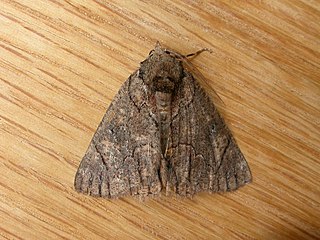
Heliomystis is a monotypic moth genus in the family Geometridae. Its only species, Heliomystis electrica, the electric moth, is found in the southern half of Australia. Both the genus and species were first described by Edward Meyrick in 1888.
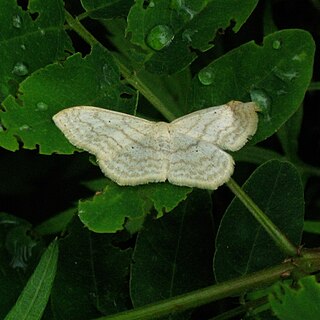
Idaea tacturata, the dot-lined wave moth, is a moth of the family Geometridae. The species was first described by Francis Walker in 1861. It is found in the US from Virginia to Florida, west to south-eastern coastal Texas.

Idaea costaria is a species of moth of the family Geometridae. It is found in south-eastern Australia.

Idaea eremiata, the straw wave moth, is a species of geometrid moth in the family Geometridae. It is found in North America.
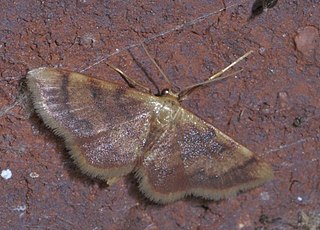
Idaea demissaria, the red-bordered wave moth, is a species of geometrid moth in the family Geometridae. It is found in North America.
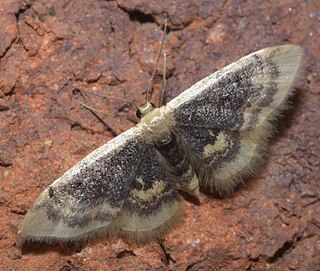
Idaea scintillularia, the diminutive wave, is a species of geometrid moth in the family Geometridae. It is found in North America.

Idaea ostentaria, the showy wave, is a species of geometrid moth in the family Geometridae.















